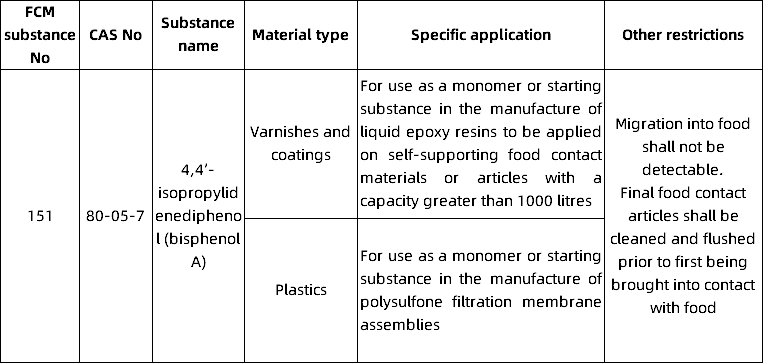The European Commission published Commission Regulation (EU) 2024/3190 on 31 December 2025, addressing the use of bisphenol A (BPA) and other bisphenols and bisphenol derivatives with harmonised classification for specific hazardous properties in certain materials and articles intended to come into contact with food, amending Regulation (EU) No 10/2011 and repealing Regulation (EU) 2018/213.
1.Entry into force: 20 January 2025
This Regulation shall enter into force on the twentieth day following that of its publication in the Official Journal of the European Union.This Regulation shall be binding in its entirety and directly applicable in all Member States.
2.Transitional Period:
2.1. single-use final food contact articles
(1)Single-use food contact articles containing BPA that do not comply with this Regulation may remain on the market until July 20, 2026.
(2)the following single
use final food contact articles, before the date of entry into force of this Regulation, which do not comply with the rules in this Regulation, may be placed on the market until 20 January 2028:
(a)single-use final food contact articles intended for the preservation of the following foodstuffs:
fruits or vegetables, excluding products defined in Annex I to Council Directive 2001/112/EC; or
fishery products as defined by Regulation (EC) No 853/2004 of the European Parliament and of the Council
(b)single-use final food contact articles on which a varnish or coating manufactured using BPA has only been applied to the exterior metal surface.
(3)Single-use final food contact articles placed on the market in accordance with (a) and (b) may be filled with food and sealed during the 12 months following the expiry of the applicable transitional period. The resulting packaged food may be placed on the market until exhaustion of stocks.
2.2. Repeat-use final food contact articles
(1)Repeat-use final food contact articles manufactured using BPA and complying with the rules as applicable before the date of entry into force of this Regulation, which do not comply with the rules in this Regulation, may be first placed on the market until 20 July 2026.
(2)By way of derogation from paragraph (1), repeat-use final food contact articles used as professional food production equipment, complying with the rules as applicable before the date of entry into force of this Regulation, which do not comply with the rules in this Regulation, may be first placed on the market until 20 January 2028.
(3)Repeat-use final food contact articles that were first placed on the market in accordance with paragraphs (1) and (2) may remain on the market until 20 January 2029 at the latest.
3.Key points of regulations
3.1. Scope of the Regulations:
This ban encompasses the materials:Adhesives,Rubbers,Ion-exchange resins,Plastics,Printing inks,Silicones,Varnishes and coatings
3.2. Requirements:
(1)The regulation prohibits the use of BPA and its salts in the production and marketing of food contact materials and articles.
(2)Food contact materials and articles that have been manufactured using another bisphenol or bisphenol derivative shall not contain any residual BPA.
(3)Additionally, the manufacture of food contact materials and articles using other hazardous bisphenols is prohibited.
3.3. By way of derogation:
(1)ANNEX II-Union list of BPA and other hazardous bisphenols and hazardous bisphenol derivatives authorised for use in the manufacture of food contact materials and articles for specific applications.

(2)The hazardous bisphenol other than BPA or hazardous bisphenol derivatives may be used in the manufacture of food contact materials and articles for a specific application and those food contact materials and articles may be placed on the market if that use has been authorised in accordance with Article 6 and is set out in Annex II.
3.4. Verification of compliance:
(1)The method shall have a detection limit of 1 μg/kg unless a different detection limit is set out in Annex II, or as part of the method recommended in accordance with the method which EURL has developed or recommended.
(2)To verify that a food contact material or article does not contain BPA, another hazardous bisphenol or a hazardous bisphenol derivative, an extraction method shall be used
(3)The verification with specific detection or migration limits shall be in accordance with Regulation (EU) No 10/2011.
3.5 Amendment to Regulation (EU) No 10/2011:
(1)In Article 6, the following paragraph is added:
‘6.By way of derogation from Article 5, 2,2-bis(4-hydroxyphenyl)propane (“bisphenol A” or “BPA”) (CAS No 80-05-7) and other hazardous bisphenols or hazardous bisphenol derivatives as defined and falling within the scope of Regulation (EU) 2024/3190 may only be used in the manufacture of plastic materials and articles in accordance with that Regulation.’
(2)in Table 1 of Annex I, the entries concerning substance No 151 (2,2-bis(4-hydroxyphenyl)propane) and substance No 154 (4,4’-dihydroxydiphenyl sulphone) are deleted.
CTT Tips:
The European Union has completely banned the use of bisphenol A in food contact materials. When manufacturing or purchasing food contact materials and products, companies should pay attention to whether bisphenol A, other bisphenols and bisphenol derivatives are intentionally added to the products. It is recommended that relevant enterprises prepare in advance to ensure that their products meet the relevant requirements before the implementation of regulations, in order to avoid affecting subsequent sales and manufacturing.
